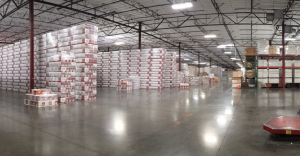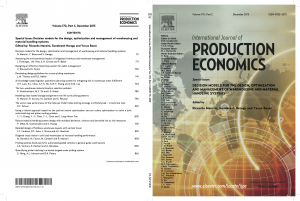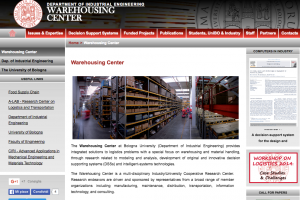A critical issue in logistics and FSC is the design, management and control of warehousing systems. Recent contributions are presented by the Food S upply Chain Center In particular, Accorsi et al. (2014a) present a supporting decision tool for the design and optimisation of a warehousing system with a special focus on storage allocation and storage assignment problems, which are two of the most critical issues. The storage decisions are significantly related
upply Chain Center In particular, Accorsi et al. (2014a) present a supporting decision tool for the design and optimisation of a warehousing system with a special focus on storage allocation and storage assignment problems, which are two of the most critical issues. The storage decisions are significantly related
with the inventory management and fulfilment problems for perishable and not perishable products.
Visit the Warehousing Center at UNIBO:
from the Special Issue on Warehousing and Material Handling (Riccardo Manzini, Yavuz Bozer , Sunderesh Heragu , 2015, Decision models for the design, optimization and management of warehousing and material handling systems. International Journal of Production Economics. Volume 170, Part C, Pages 711-716)
[…]
 For many companies, warehousing and materials handling (MH) are essentially non-value added activities. Storing a product on a shelf or moving it in and out of storage racks does not add value to the product. However, both are important elements in a supply chain and play a critical role in providing efficiency and customer satisfaction. Warehousing and material handling allow matching vendor supply with customer demand, smoothing demand for seasonal products, consolidating products, customizing product or packaging and arranging distribution activities. Furthermore, for certain service providers such as logistics/transportation companies and third-party logistics providers, part of the warehousing and MH activities including personalizing a package or repairing a product are value-add activities because their customers are willing to pay for those key services.
For many companies, warehousing and materials handling (MH) are essentially non-value added activities. Storing a product on a shelf or moving it in and out of storage racks does not add value to the product. However, both are important elements in a supply chain and play a critical role in providing efficiency and customer satisfaction. Warehousing and material handling allow matching vendor supply with customer demand, smoothing demand for seasonal products, consolidating products, customizing product or packaging and arranging distribution activities. Furthermore, for certain service providers such as logistics/transportation companies and third-party logistics providers, part of the warehousing and MH activities including personalizing a package or repairing a product are value-add activities because their customers are willing to pay for those key services.
Warehousing and MH involve solving a large number of important design and operational problems in production/distribution systems and economics research. Both are critical topics of interest for industry, managers, practitioners, public and private research, including academic research, because of various factors such as cost, efficiency, profit, environmental impact, risks, maintenance, safety and ergonomics. Determining the location of a warehouse and its design are strategic problems that must be addressed at the outset of many supply chain design projects. It is important to know the size of the warehouse, often measured in terms of the number of storage locations by unit load/rack type. The appropriate size for a warehouse depends on the application and the type of warehouse as well as the expected number of storage and retrieval transactions during peak and off-peak times, among many other factors. The latter depends upon supply, demand and their timing. Once the warehouse size is determined, decisions on its footprint, ideal height and other factors need to be made. Selection of the appropriate material handling equipment has an impact on the footprint as well as the height decision and vice-versa. Thus, like many problems in facility logistics, this is a classical chicken-or-the-egg problem. In addition to the size, the footprint and height decisions, the size of the key areas in the warehouse such as receiving/shipping, reserve, forward, staging, sortation, and cross-docking must be determined […]
